Aircraft Propulsion (Theory)
1/55
There's no tags or description
Looks like no tags are added yet.
Name | Mastery | Learn | Test | Matching | Spaced |
|---|
No study sessions yet.
56 Terms
Sketch the T-S & P-V plots in the Brayton Cycle. Explain them.
The Brayton cycle depicts an idealized performance cycle for gas turbines, comprising of compressor, combustor, turbine, and exhaust processes.
The T-S example shows compression, resulting in temperature increase, thus entropy (aka system disorder), followed by combustion, adding significant heat and more energy thus entropy. Followed by cooling across the turbine, and finally exit via exhaust nozzle, losing all energy.
The P-V example displays air being compressed, thus pressure increases whilst volume decreases. Then, combustion, pressure remains the same but the volume wishes to expand with the added heath. Pressure drops across the turbine, whilst volume increases, and finally, pressure returns to atmospheric standards as volume increases following thrust production.
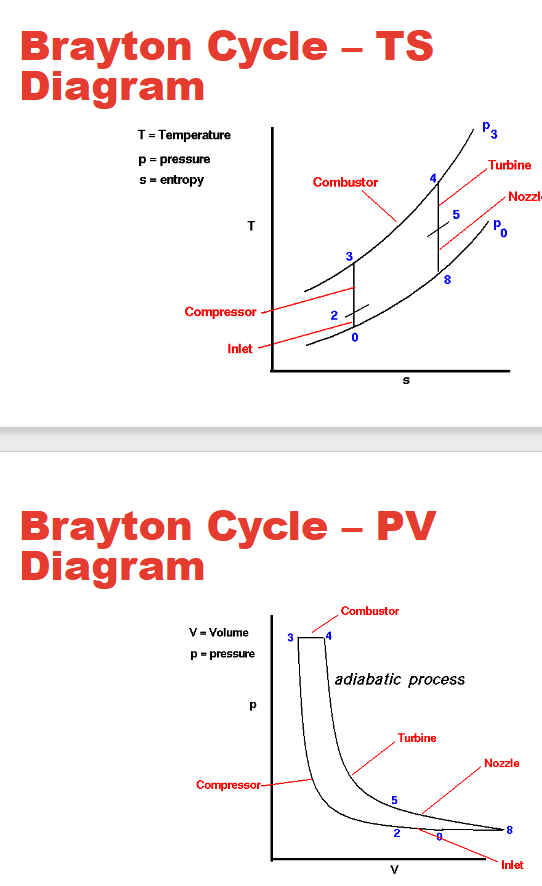
Define ‘Entropy’
A measure of the disorder or randomness in a system, reflecting the amount of energy not available for work.
It also displays energy spread, i.e. concentrated energy = low entropy, evenly spread energy = high entropy.
Entropy most commonly increases with heat, as particles begin to move about more.
In the Brayton Cycle, entropy shows how much useful energy is lost in each process, given that entropy increases through each gas turbine stage, thus potential energy is lost.
Define ‘Enthalpy’
The total heat content of a system especially useful when considering airflow through engines for example.
Enthalpy = Internal Energy + Flow Energy
Since heat is also known as thermal energy, enthalpy can be used to simplify the display of how much energy is gained or lost through a system, reducing heat, work, flow, all down to one term.
Write in detail the operation of a turbojet engine with a neat sketch.
A turbojet engine operates by drawing in 100% of available air through an intake, compressing it with a multi-stage compressor, and then mixing it with fuel in the combustion chamber.
The mixture ignites, generating high-temperature, high-pressure exhaust gases that expand through a turbine, powering the compressor, and exit through the nozzle to produce thrust.
This cycle continues as the engine operates.
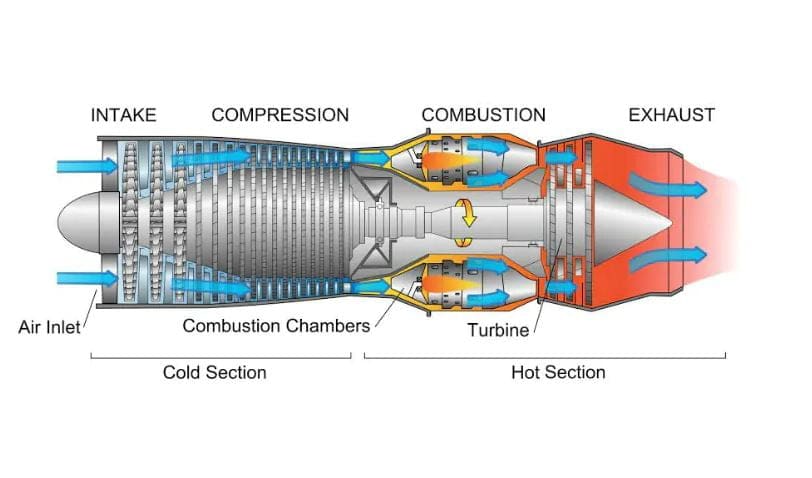
List the main types of aircraft engines.
Turbofan
Turbojet
Turboprop
Turboshaft
Write in detail about the operation of a turboprop engine with a neat sketch.
A turboprop engine combines a gas turbine engine with a propeller to produce thrust. Air is drawn into the engine, compressed, mixed with fuel, and ignited in the combustion chamber. The resulting high-pressure gases drive a turbine, which powers the propeller, providing both thrust and increased efficiency at lower speeds compared to turbojet engines.
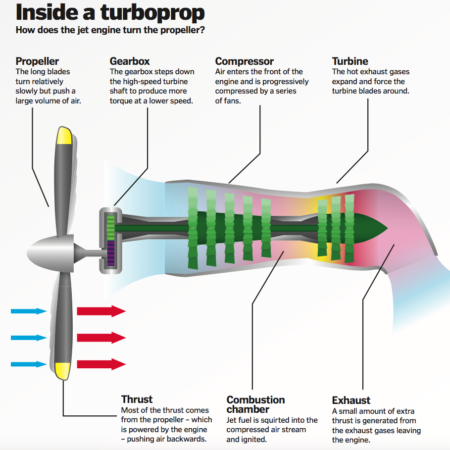
Write in detail about the operation of a turbofan engine with a neat sketch.
A turbofan engine operates by drawing in air through a large fan at the front, with a portion bypassing the core of the engine. The remaining air is compressed by a multi-stage compressor, mixed with fuel, and ignited in the combustion chamber. The high-temperature gases expand through a turbine, which drives the compressor and fan, while exhaust gases contribute to thrust. This design provides improved efficiency and noise reduction compared to turbojet engines.
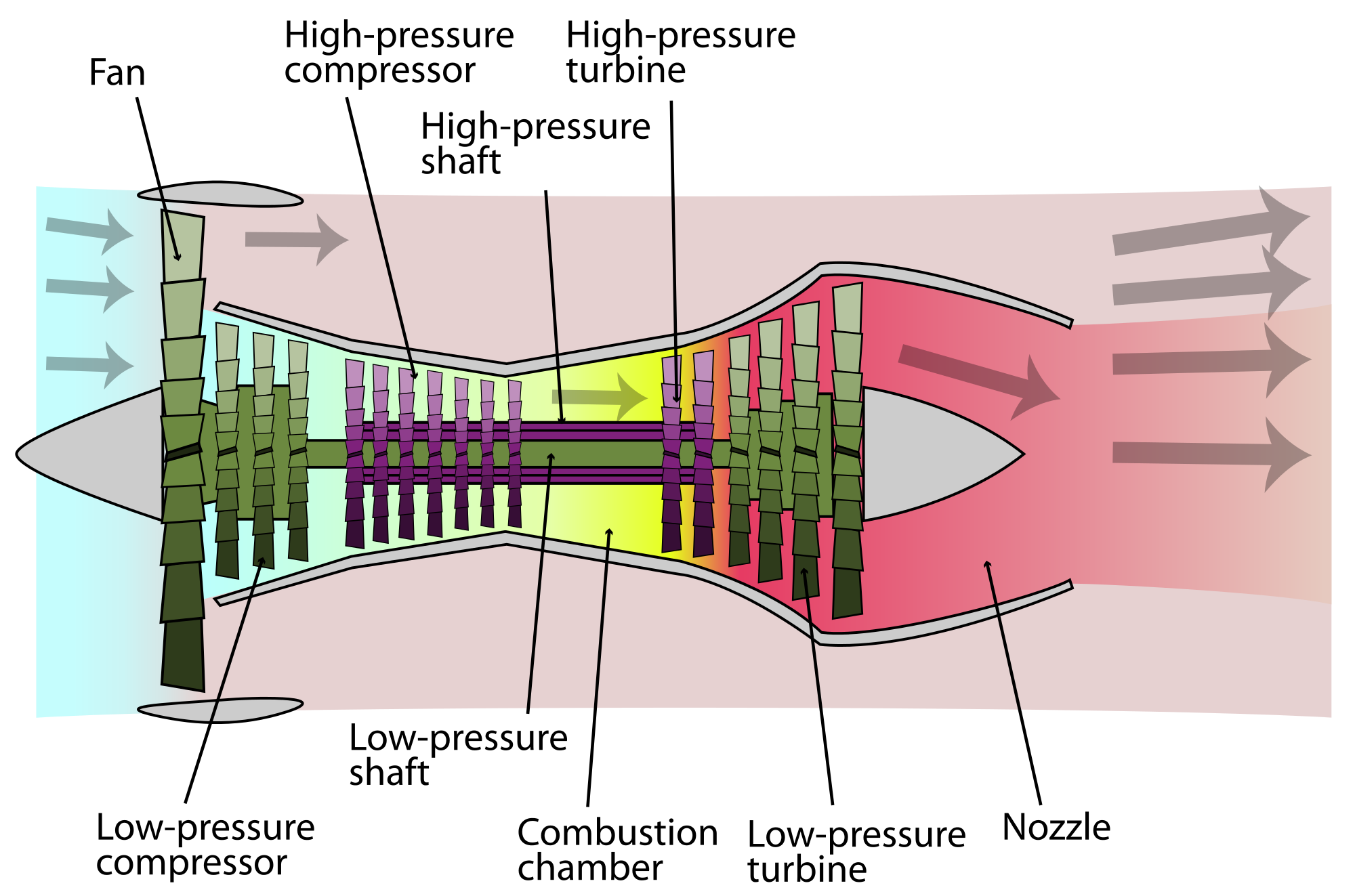
Compare the performance characteristics of turbojet, turbofan and turboprop.
Turbojets excel in high-speed operations at high altitudes but are less efficient at low speeds.
Turbofans offer improved fuel efficiency and lower noise levels, making them ideal for commercial aviation.
Turboprops are most efficient at low to medium speeds and are well-suited for short-haul flights, providing better performance and fuel economy in those ranges.
Write in detail about the operation of a ramjet engine with a neat sketch.
Ramjets are special engines with no moving parts, designed for use above Mach 2 by relying on existing aircraft speed.
During high speed travel, air is rammed into the engine, compressing it through sheer velocity, where it is then slowed via the shape of the inlet.
The naturally compressed air is then mixed with fuel and ignited in the combustion chamber, creating high-pressure gases that are expelled out the nozzle to produce thrust.
This design is highly efficient at supersonic speeds, but ramjets require an initial speed to operate effectively and cannot start from a standstill.
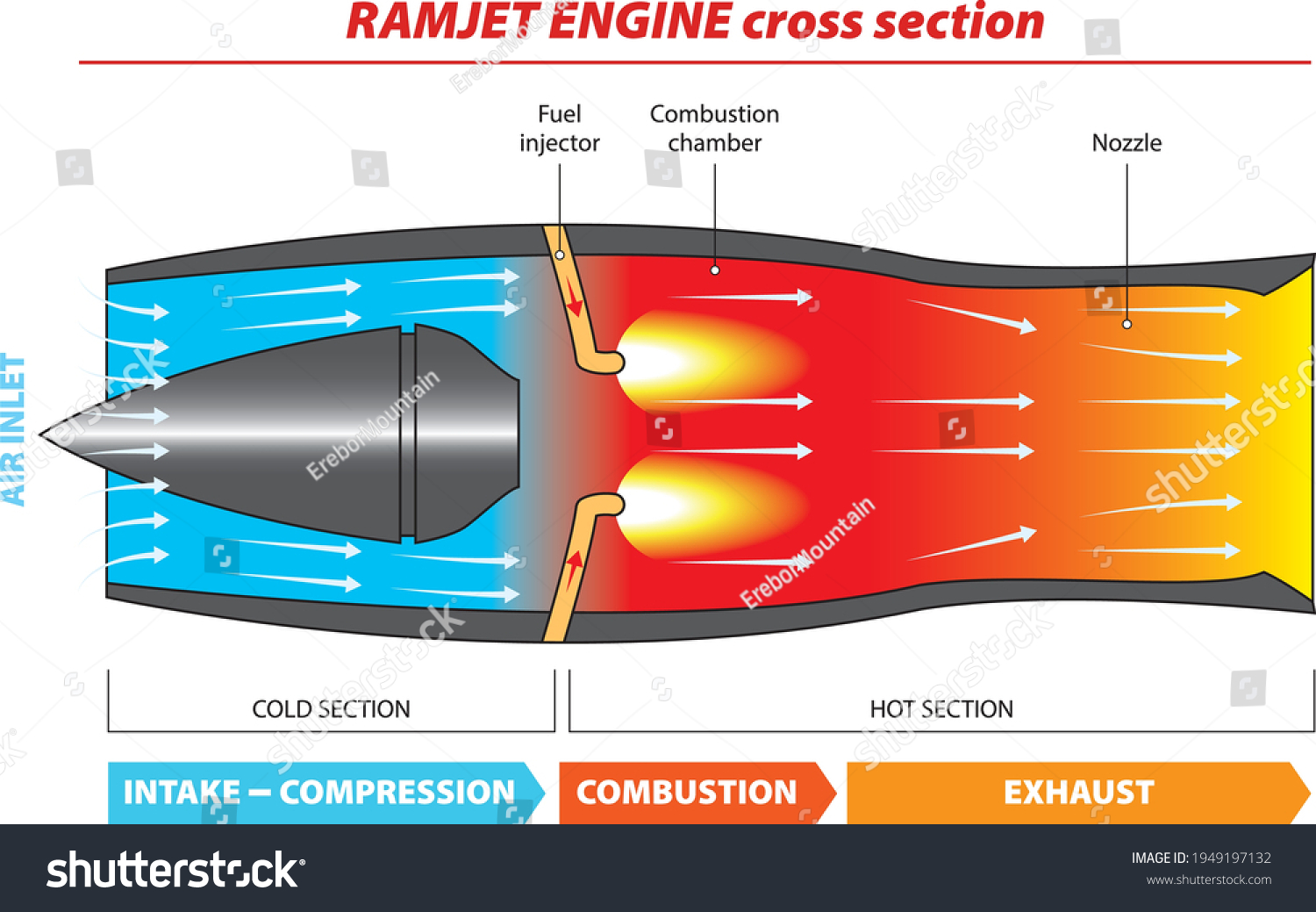
Write in detail about the operation of a Scramjet engine with a neat sketch.
Scramjets are an advanced form of Ramjets, designed for efficient operation through mach 5 and above.
Unlike ramjets however, scramjets utilize supersonic combustion, allowing air to flow through the engine at supersonic speeds without slowing it down, mixing fuel directly with the high-speed airflow for combustion. This results in high thrust efficiency at extreme velocities, making them suitable for hypersonic flight.
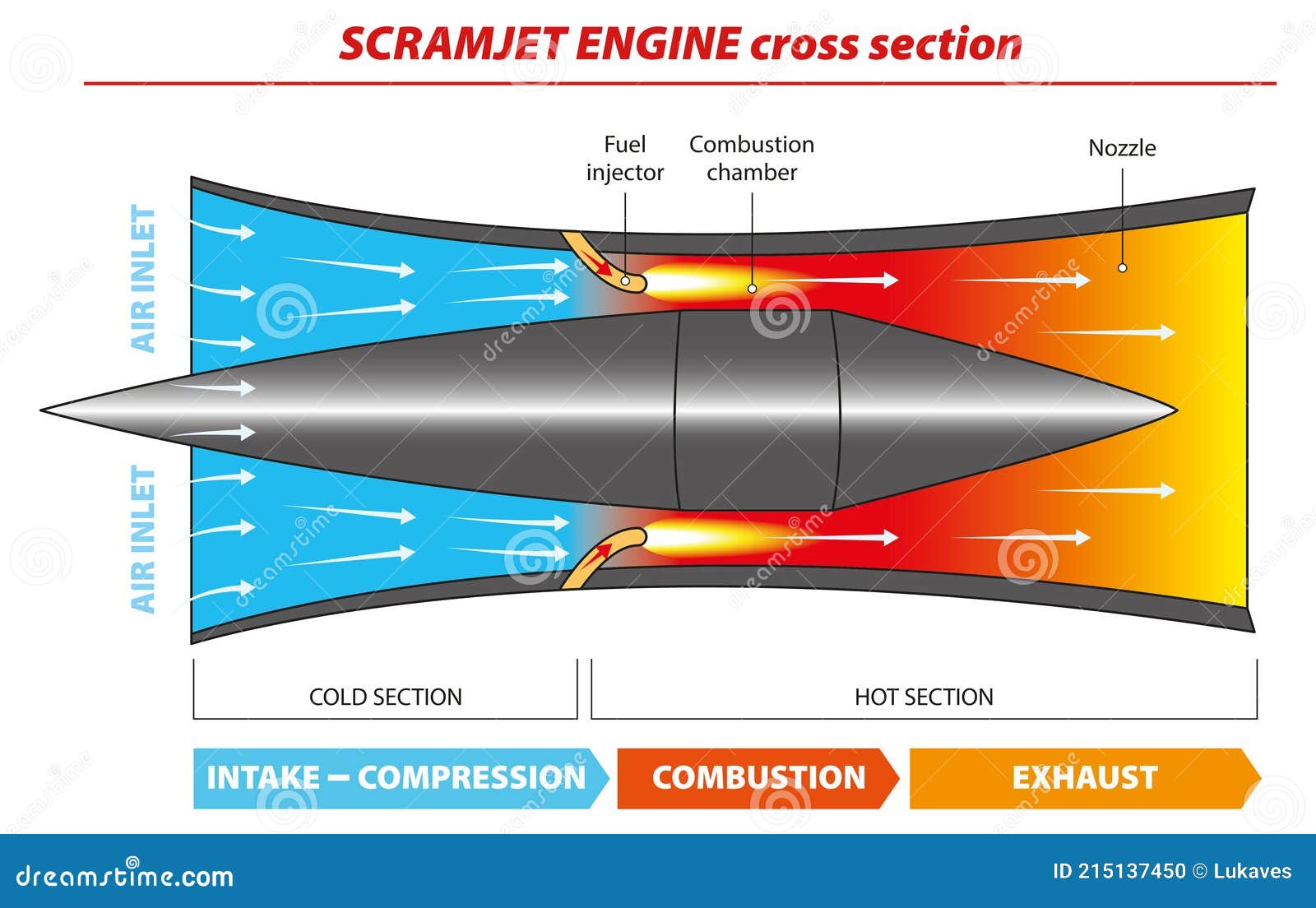
What are the functions of an intake in aircraft engine?
Above all, efficient air capture across various speeds and altitudes.
Preventing flow separation, feeding non-turbulent airflow to the compressor.
Minimise shockwave formation at supersonic speeds through intake shaping.
In supersonic aircraft, intakes may also implement specialise shaping to slow intake air to subsonic speeds (excl. scramjet), and sometimes also compressing air naturally, removing the need for a compressor stage i.e. ramjet.
Explain ‘Spillage Drag’
Conditions where the engines airflow demands are not met by the intake, i.e. not enough air being fed into the engine, reducing efficiency and even leading to stalls or surges.
This most commonly occurs when a given intake is not designed for current aircraft conditions i.e. excessive altitude, minimal speed, etc…
Oppositely, the engine may not be demanding as much air as is flowing into it, i.e. during low-speed or low throttle conditions.
What is the main use of blow-in doors?
These are spring-loaded doors installed in the perimeter of the inlet duct, designed to deliver additional air to the engine during take-off and climb conditions, where maximum thrust is required, but aircraft and thus inlet speed is low.
What is the most common subsonic intake type and why?
This is the pitot intake, because it makes the fullest use of ram air due to forward speed, suffering minimal loss of ram pressure pressure across altitude change
List the different types of pitot-intakes.
Podded
Integrated
Flush
Write short notes on ‘subsonic intakes during take-off and cruise’
Subsonic intakes during take-off and cruise are designed to optimize airflow into the engine under varying conditions. During take-off, they ensure maximum air delivery by utilizing features like blow-in doors; while in cruise, they stabilize airflow to maintain efficiency and performance.
Define ‘stagnation pressure ratio’
Defined as the ratio between average total pressure of air entering the engine to that of the free-stream air.
Define ‘Isentropic Efficiency’ of the intake
Quantifies how efficiently the intake compresses air compared to an ideal, lossless (isentropic) process.
It reflects how much pressure loss occurs as air moves from the free stream to the engine face.
How are turboprop intakes different from other engine types?
These are complicated due to the presence of a bulk gearbox, however aerodynamically efficient turboprops are achieved through use of a ducted spinner.
Intake performance is improved by maximising entry area.
Briefly explain supersonic intakes
Supersonic intakes are designed to efficiently capture and decelerate incoming airflow at speeds greater than the speed of sound.
They commonly utilise a supersonic diffuser, where intake flow is decelerated to subsonic conditions suitable for engine processes such as compression and combustion.
Define ‘Capture Area’
The surface area of an intake that effectively catches airflow, impacting the overall performance and efficiency of the engine.
For supersonic intakes, this is the area enclosed by the leading edge, including the cross-sectional area of the forebody.
Write short notes on Axisymmetric intake.
These use an axisymmetric central cone to shock the flow down to subsonic speeds.
Write short notes on Variable Geometry intake.
These often use a central cone which may move fore and aft in order to ADJUST the present intake area.
Alternatively, the inlet area may be adjusted via rectangular sections such as hinged flaps or ramps, altering airflow angles.
What is meant by mixed compression intakes?
Mixed compression intakes are a type of air intake design that combines subsonic and supersonic flow characteristics, allowing for effective airflow management across a range of speeds. They use both a shock wave and a diffuser to compress air efficiently.
In what direction does the flow gets turned inside a centrifugal compressor?
The flow through the centrifugal compressor is turned perpendicular to the axis of rotation.
What are the three main elements of a centrifugal compressor?
Impeller
Stator
Manifold or Collector
Explain the terms Slip & Slip Factor
Slip is the difference or deviation between actual flow, and ideal / theoretical flow.
Slip factor (σ) is the quantifiable ratio of slip, given by actual whirl velocity divided by ideal whirl velocity.
What are the four main elements of an axial compressor?
Front frame
Casing with inlet stator vanes
Rotor with rotor blades
Rear frame
What are the functions of a stator and rotor in an axial compressor?
Rotors add kinetic energy, accelerating air, increasing its velocity, where its then passed to the stator, which turns velocity to pressure, slowing the air, increasing pressure, repeat.
This is the axial equivalent of a diffuser and impeller in a centrifugal compressor.
Using a sketch, explain the flow changes witin an axial compressor.
The flow changes within an axial compressor involve a series of stages where air is drawn in, accelerated by rotor blades, and then decelerated by stator vanes. This process continually transforms kinetic energy into pressure energy, enhancing the overall efficiency of air compression.
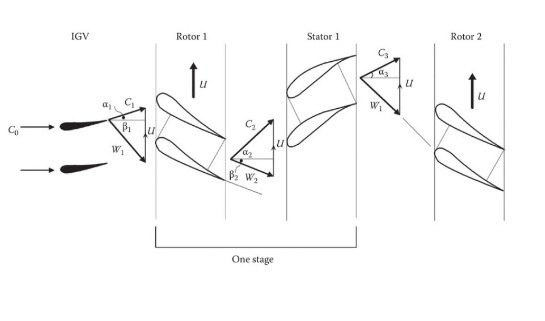
Write short notes on stall & surge
A stall describes a situation of abnormal airflow through one or more stages of the compressor. If all stages stall together, this becomes a more serious compressor surge, resulting in a loss of engine power.
What are the advantages of an axial flow compressor?
Superior mass flow rate
Smaller frontal area required
Higher max pressure ratio
What are the advantages of a centrifugal flow compressor?
Simplicity of construction
Cheaper to manufacture
Shorter stage length required
Less severe stall tendencies
List the three combustion chamber types.
Can or Tubular
Annular
Can-Annular or Tubo-Annular
Write short notes on Can type combustors.
Cylindrical chambers disposed around the shaft between compressor and turbine, all interconnected.
These are no longer used as they require a large frontal area, are heavy, and present too much pressure loss in operation.
Write short notes on Annular type combustors.
A liner mounted inside a single casing, resulting in a clean aerodynamic layout best suited for axial-flow compressor engines.
An ideal combustor style, with minimal pressure loss and compact design.
Write short notes on Can-annular type combustors.
A series of cylindrical burners arranged within a single annulus, combining the compactness of annular chamber but with the best performance features of tubular.
Quite compact (not the smallest though)
Short & Lighter
Minimal pressure loss in operation
What are the main components of a combustion chamber?
Casing
Diffuser
Liner
Snout
Dome or Swirler
Fuel Injector
Igniter
What are the two primary steps in aircraft engine combustion?
Introduction of liquid fuel via a fine atomised spray, mixing with primary air, vaporizing it.
Combustion of vaporized fuel and the thorough mixing with secondary added air.
What happens in the primary zone of a combustion chamber?
Primary air shaped by the snout and swirled by the swirl vanes enters the chamber where it is mixed with fuel and ignited
What happens in the dilution zone of a combustion chamber?
Secondary air is then progressively introduced, ensuring any remaining fuel is burnt, whilst simultaneously aiding in cooling the chamber, reducing excess emissions.
Define ‘Stoichiometric Ratio’
Air to fuel ratio, required to complete combustion of a hydrocarbon fuel. It is the ideal ratio in which all fuel is burned using all available oxygen, resulting in complete combustion and minimal emissions.
What is meant by combustion stability?
Smooth burning and the ability of the flame to remain alight over a wide operating range. It ensures consistent performance in combustion systems, preventing issues such as flame extinction or oscillation.
Define ‘Combustion Intensity’
Ratio between heat released by a combustion chamber and the volume of the combustion area x pressure. It measures the efficiency and effectiveness of the combustion process.
List the three types of flame holders used in afterburners.
Conical
Cylindrical Baffle
Vee-gutter (widely used!)
What are the two main components in a turbine stage?
Rotor - A rotating part of the turbine consisting of a blade attached to a shaft. It converts high pressure and high thermal energy from the combustion process to mechanical energy, used to drive the compressor, generators, etc…
Stator - A stationary part of the turbine consisting of blades or vanes that guide the flow of gases in an ideal manner onto the rotor blades. In other words, stator maximises efficiency and converts pressure energy into kinetic energy.
Why would the turbofan and turboprop require two-spool engines?
A two-spool engine setup allows independent operation of the low-pressure and high-pressure turbines, optimizing efficiency and thrust across varying flight conditions.
This configuration enhances the performance and efficiency of turbofans and turboprops, particularly in varied speed and altitude scenarios, which these engines are prevalently used within.
What are the functions of NGV’s in turbines?
NGVs, or Nozzle Guide Vanes have several functions within turbines…
Directing gas flow from the combustion chamber to the rotor blades.
Control velocity and pressure of gas entering the rotor stage.
Optimise flow for maximum effieciency.
They also help reduce turbulence and ensure smooth operation by maintaining the proper angle of attack for the rotor blades.
What is the difference between axial and radial turbines?
There are several differences…
Axial turbines are designed with the working fluid moving in parallel aka axial. Radial turbines work with fluid in a perpendicular manner, aka radial.
Axial are suited for larger high power applications, whereas radial are best in small concentrated equivalents.
Axial rotors extract energy from the fluid as it moves in the same direction of the axis of rotation, like the straight line of an engine, whereas radial turbines extract this by directing fluid outward from the centre, which can be less efficient in such a system.
Distinguish between reaction and impulse turbines.
Reaction turbines generate thrust by the change in pressure of the fluid as it flows through the turbine, while impulse turbines generate thrust through the momentum of high-velocity jets striking the rotor blades, causing rotational movement.
Sketch the velocity triangle for one-stage of an axial turbine and explain it in detail.
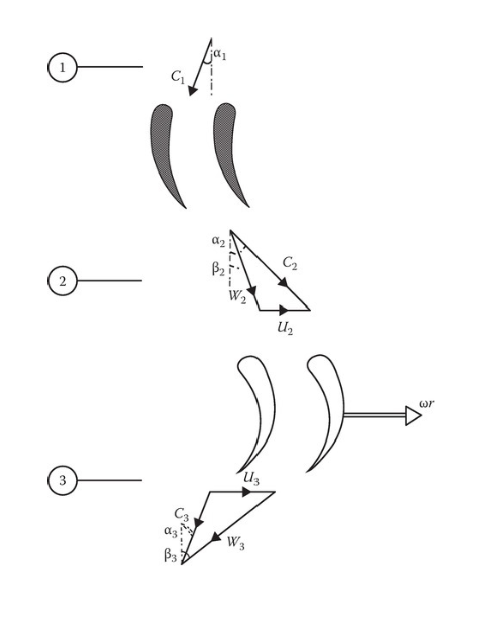
Explain centrifugal stress
This is a stress experienced by rotating components like turbine blades due to the centrifugal force generated by their rotation.
It can lead to material fatigue and thus eventual failure if improperly designed and maintained, hence the importance of these processes.
Explain Gas Bending Stress
This is a stress developed in thin-walled components, most notably turbine blades, as a result of the constant, sometimes uneven gas flow exerted upon them, creating slight bends.
This bending can cause deformation and even failure, hence blades must be designed to resist such effects, and be regularly inspected for signs of gas bending.
Explain Thermal Stress
This is a stress derived from the expansion and / or contraction of material due to fluctuation in surrounding temperature.
This process is often uneven, resulting in internal stresses, which can crack, warp and distort components.
What is meant by cooling effectiveness parameter?
The cooling effectiveness parameter is a measure of how effectively a cooling system reduces the temperature of a component or fluid compared to the temperature difference between the component and the coolant.
It is essential for optimizing engine performance and preventing overheating.
List the different types of losses in the turbine:
Profile Loss
Annulus Loss
Secondary Flow Loss
Secondary Loss Coefficient
Tip Clearance Loss